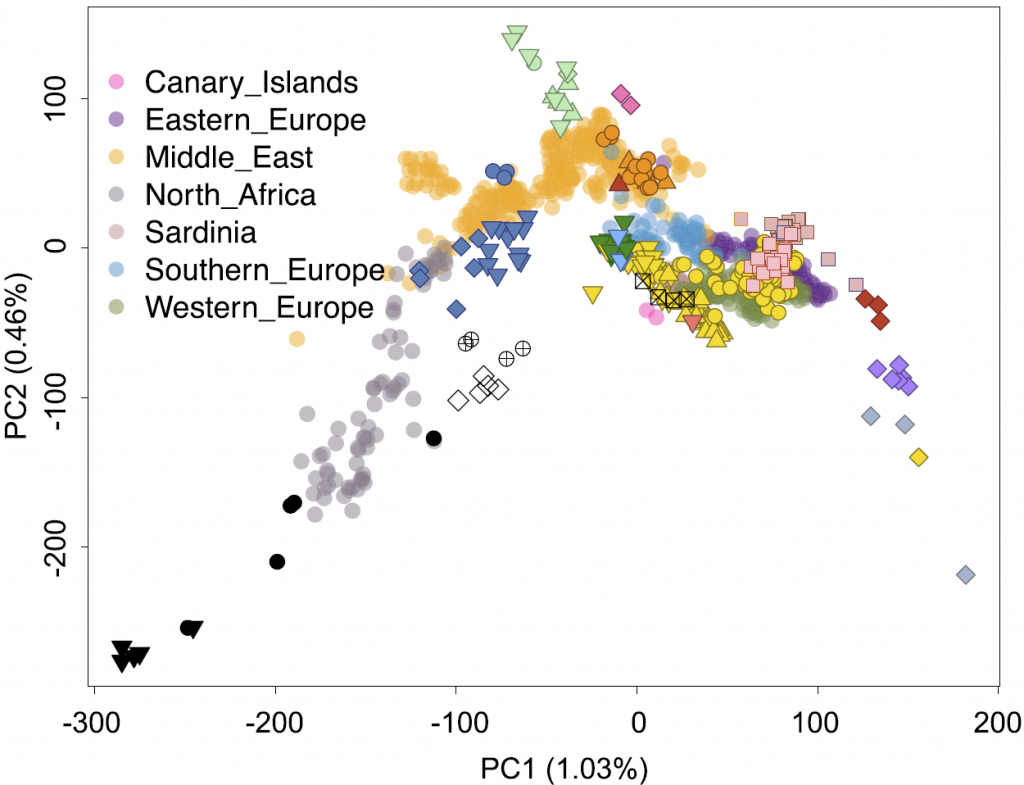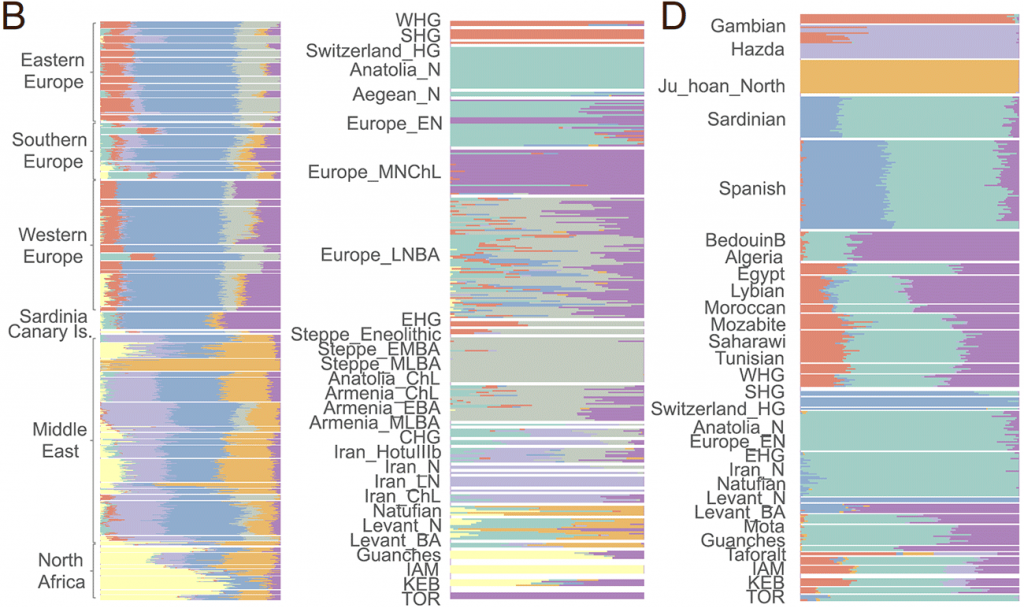BioRxiv preprint now published (behind paywall) Ancient genomes from North Africa evidence prehistoric migrations to the Maghreb from both the Levant and Europe, by Fregel et al., PNAS (2018).
NOTE. I think one of the important changes in this version compared to the preprint is the addition of the recent Iberomaurusian samples.
Abstract (emphasis mine):
The extent to which prehistoric migrations of farmers influenced the genetic pool of western North Africans remains unclear. Archaeological evidence suggests that the Neolithization process may have happened through the adoption of innovations by local Epipaleolithic communities or by demic diffusion from the Eastern Mediterranean shores or Iberia. Here, we present an analysis of individuals’ genome sequences from Early and Late Neolithic sites in Morocco and from Early Neolithic individuals from southern Iberia. We show that Early Neolithic Moroccans (∼5,000 BCE) are similar to Later Stone Age individuals from the same region and possess an endemic element retained in present-day Maghrebi populations, confirming a long-term genetic continuity in the region. This scenario is consistent with Early Neolithic traditions in North Africa deriving from Epipaleolithic communities that adopted certain agricultural techniques from neighboring populations. Among Eurasian ancient populations, Early Neolithic Moroccans are distantly related to Levantine Natufian hunter-gatherers (∼9,000 BCE) and Pre-Pottery Neolithic farmers (∼6,500 BCE). Late Neolithic (∼3,000 BCE) Moroccans, in contrast, share an Iberian component, supporting theories of trans-Gibraltar gene flow and indicating that Neolithization of North Africa involved both the movement of ideas and people. Lastly, the southern Iberian Early Neolithic samples share the same genetic composition as the Cardial Mediterranean Neolithic culture that reached Iberia ∼5,500 BCE. The cultural and genetic similarities between Iberian and North African Neolithic traditions further reinforce the model of an Iberian migration into the Maghreb.

Relevant excerpts:
FST and outgroup-f3 distances indicate a high similarity between IAM and Taforalt. As observed for IAM, most Taforalt sample ancestry derives from Epipaleolithic populations from the Levant. However, van de Loosdrecht et al. (17) also reported that one third of Taforalt ancestry was of sub-Saharan African origin. To confirm whether IAM individuals show a sub-Saharan African component, we calculated f4(chimpanzee, African population; Natufian, IAM) in such a way that a positive result for f4 would indicate that IAM is composed both of Levantine and African ancestries. Consistent with the results observed for Taforalt, f4 values are significantly positive for West African populations, with the highest value observed for Gambian and Mandenka (Fig. 3 and SI Appendix, Supplementary Note 10). Together, these results indicate the presence of the same ancestral components in ∼15,000-y old and ∼7,000-y-old populations from Morocco, strongly suggesting a temporal continuity between Later Stone Age and Early Neolithic populations in the Maghreb. However, it is important to take into account that the number of ancient genomes available for comparison is still low and future sampling can provide further refinement in the evolutionary history of North Africa.
Genetic analyses have revealed that the population history of modern North Africans is quite complex (11). Based on our aDNA analysis, we identify an Early Neolithic Moroccan component that is (i) restricted to North Africa in present-day populations (11); (ii) the sole ancestry in IAM samples; and (iii) similar to the one observed in Later Stone Age samples from Morocco (17). We conclude that this component, distantly related to that of Epipaleolithic communities from the Levant, represents the autochthonous Maghrebi ancestry associated with Berber populations. Our data suggests that human populations were isolated in the Maghreb since Upper Paleolithic times. Our hypothesis is in agreement with archaeological research pointing to the first stage of the Neolithic expansion in Morocco as the result of a local population that adopted some technological innovations, such as pottery production or farming, from neighboring areas.
By 3,000 BCE, a continuity in the Neolithic spread brought Mediterranean-like ancestry to the Maghreb, most likely from Iberia. Other archaeological remains, such as African elephant ivory and ostrich eggs found in Iberian sites, confirm the existence of contacts and exchange networks through both sides of the Gibraltar strait at this time. Our analyses strongly support that at least some of the European ancestry observed today in North Africa is related to prehistoric migrations, and local Berber populations were already admixed with Europeans before the Roman conquest. Furthermore, additional European/ Iberian ancestry could have reached the Maghreb after KEB people; this scenario is supported by the presence of Iberian-like Bell-Beaker pottery in more recent stratigraphic layers of IAM and KEB caves. Future paleogenomic efforts in North Africa will further disentangle the complex history of migrations that forged the ancestry of the admixed populations we observe today.

Also, from the main author’s Twitter account:
I just realized that the paragraph with information on data availability is missing! Sequence data in the European Nucleotide Archive (PRJEB22699). Consensus mtDNA sequences are available at the National Center of Biotechnology Information (Accession Numbers MF991431-MF991448).
I find it hard to believe that this genetic continuity from Upper Palaeolithic to Late Neolithic could be representative of an autochthonous development of Afroasiatic. An important population movement – likely more than one – must be found in ancient DNA influencing North-Central and North-East Africa, probably during the time of the Green Sahara corridor.
See here:
- Tales of Human Migration, Admixture, and Selection in Africa
- Pleistocene North African genomes link Near Eastern and sub-Saharan African human populations
- Genetic ancestry of Hadza and Sandawe peoples reveals ancient population structure in Africa
- R1b-V88 migration through Southern Italy into Green Sahara corridor, and the Afroasiatic connection
- Potential Afroasiatic Urheimat near Lake Megachad
- Expansion of peoples associated with spread of haplogroups: Mongols and C3*-F3918, Arabs and E-M183 (M81)
- Genetic landscapes showing human genetic diversity aligning with geography
- Human ancestry solves language questions? New admixture citebait